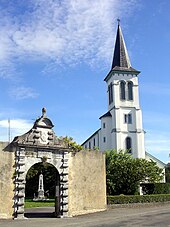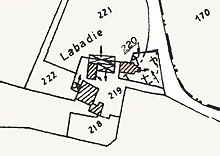Lay monastery

A lay monastery ( French abbaye laïque ) was a religious institution of the Middle Ages and early modern times in France in the western foothills of the Pyrenees . The first part of the double word, " lay people ", indicates that the institutions did not belong to any order and that their members were neither clerics nor monks .
The basis for the establishment of a lay monastery was the collection and distribution of tithe for the maintenance of the church, the pastor and for the support of the poor in a parish.
introduction
According to records from the 11th to 13th centuries, abbadies , a term from the Gascognic language, were the houses of people who called themselves abbots ( French abbé , Basque abat ) but were not clerics. The words abbot and abbe come from the late Latin and late Greek abbas and the Aramaic ab ạ ' ( German father ). The term lay monastery only developed in the modern era.
The building of the lay monastery was always not far from the church, sometimes even attached to the church building. The abbot of a lay monastery had the right to suggest the pastor, sometimes had its own entrance to the church and was usually buried there. He was freed from the control over his feudal lord, but had the other hand, the oath of allegiance to the Vicomte speak and move if necessary for him to war.
Lay monasteries generally existed in the inner catchment area of the Adour River . This was mainly the case in the historical regions of Béarn and Bigorre , but also in neighboring regions, in the west the Soule , in the north the Chalosse and the Tursan, the southern Armagnac , the Astarac , the valley of the Aure .
Sources speak of around 100, others of around 300 lay monasteries that can be identified, some of them only based on assumptions due to a lack of records. Paul Raymond, archivist and historian of the 19th century, listed in his 1863 work Dictionnaire topographique du département des Basses-Pyrénées 145 earlier lay monasteries in what is now the Département Pyrénées-Atlantiques .
history

For a long time, the assumptions of the historian Pierre de Marca, author of the work Histoire de Béarn published in 1640, were valid . He assumed that lay monasteries were founded by decrees of Charlemagne or Louis the Pious in view of the advancing Arabs and Moors in Spain in order to persuade the landlords to continue the war on the borders.
This interpretation is discussed in many directions by today's historians. Léon Cadier saw the raids of the Vikings as the cause, which devastated the villages of the Béarn in the 10th century, and lay people used the power vacuum to illegally appropriate the office. Jacques de Font-Réaulx thinks it most plausible to see the abbots as heirs to the founders of the parish churches. Philippe Araguas, on the other hand, regards the abbots as descendants of an upper class of the pre-feudal era. Since records are rare before the 11th century, it is currently difficult to verify or disprove theses.
The office lasted until the French Revolution , when the obligation to raise a tithe expired and with it the basis for lay monasteries. However, the office was aware of certain developments in the 1000 years of its existence. Lay monasteries were newly founded or disappeared, enlarged or reduced in size, were raised to the nobility or outsourced.
Web links
- www.lebearn.net/abbayeslaiques.html (French)
- Anne Berdoy: Abbayes laïques et domenjadures: l'habitat aristocratique en haut Béarn (French)
- Anne Berdoy: Abbayes laïques et villages de fondation médiévaux (French)
- Benoît Cursente: Les abbadies ou abbayes laïques: dîme et société dans les pays de l'Adour (XIe-XVIe siècles) (French)
- Les abbayes laïques (PDF, French)
Individual evidence
- ↑ duden.de
- ^ Paul Raymond: Dictionnaire topographique du département des Basses-Pyrénées ( fr ) In: Dictionnaire topographique de la France . Imprimerie nationale. 1863. Retrieved October 4, 2017.
- ↑ Pierre de Marca: Histoire de Béarn ( fr ) Veuve Jean Camusat. Pp. 121-125. 1640. Retrieved October 4, 2017.
- ^ Léon Cadier: Les États de Béarn ( fr ) Imprimerie Nationale. P. 70, 1888. Retrieved October 4, 2017.
